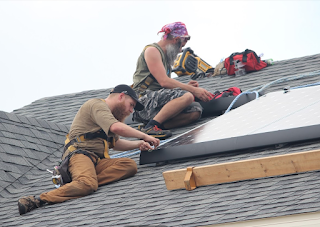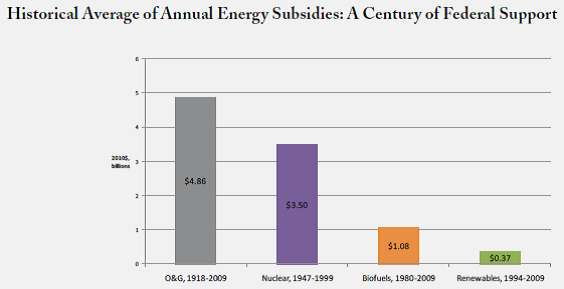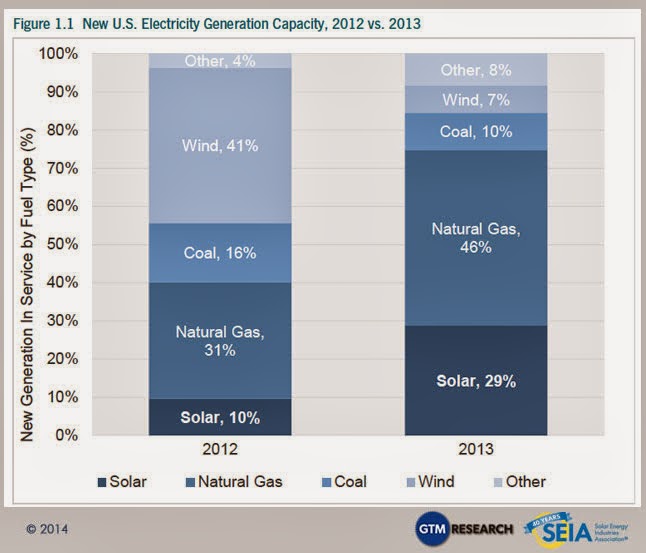
by jboullion | Oct 20, 2016 | Uncategorized
Today, the Public Service Commission of Wisconsin authorized
approximately $7.7 million in rebates spanning 2017 and 2018 to spur small,
customer-based renewable energy projects throughout Wisconsin.
The rebates go to residential, business, and non-profit
customers of eligible Wisconsin utilities, and enable the customers to install
renewable energy technologies including solar, geothermal, biogas, biomass and
small wind systems.
 |
| Full Spectrum Solar installs a solar PV system via the MadiSUN program |
|
Tyler Huebner, Executive Director of RENEW Wisconsin, said,
“From our renewable energy perspective, Chairperson Ellen Nowak may have said
it best in her concluding remarks, stating, ‘This is a great win for
Wisconsin.’ Indeed, continuing the highly successful renewable energy rebates
for 2017 and 2018 is a great win. This
level of renewable energy rebate funding should support upwards of 500 solar
electric home installations, 70 or more home geothermal installations, and
dozens of larger business renewable energy projects for each of the next two
years. The program will help our
residents save money and our companies stay cost-competitive.”
The Commission asked Staff to recommend how the renewables
funding should be split between residential and business projects, as well as a
review of the incentive levels in light of the fact that technology prices for
renewable energy systems, specifically solar electric systems, have been
dropping very quickly in recent years.
RENEW Wisconsin will provide our recommendations, and those of the
renewable energy industry, to Commission Staff in the coming days.
In addition, the Commission will evaluate spending $10-$20
million to expand biogas production from anaerobic digesters on dairy
farms. Staff and program administrators
will be developing biogas program options for the Commission to investigate
within 30 days, along with program options for increasing Focus on Energy’s
energy efficiency and renewable energy impacts in rural Wisconsin.
The Commission agreed to lower its cash reserve from $30
million down to $5 million, which freed up dollars carried over from previous
years to be put into programs starting in 2017.
Huebner said, “We applaud the Commission freeing up millions of dollars
of ratepayers’ money from previous years to be put into programs now that will
enable energy and dollar savings for customers across Wisconsin.
RENEW Wisconsin was the lead advocacy organization promoting
the continuation of the renewable energy rebates. We provided two separate memos describing the
history and status of the renewable energy industry and its relationship with
Focus on Energy and advocating for a continuation of rebates. In addition, a sign-on letter promoting
continuation of renewable energy rebates, which was supported by 41 businesses
and organizations from throughout Wisconsin, was delivered to the PSC as part
of the public comment period in this proceeding.
The PSC had authorized a renewable energy loan program in
2014 and allocated $10 million to it over four years. Today, approximately two years into the
program, the PSC decided to end the program and spend the remaining funds
instead on rebates, which had outperformed the loan program in that two year
period.
Biogas production through anaerobic digesters will also see
a boost. The PSC re-committed to
spending $6.4 million on this technology, which it had authorized in 2014. An initial plan to focus on smaller dairy
farms was not as effective as envisioned.
Today, the PSC authorized the creation of an interagency working group
to identify opportunities to expand this technology and its benefits of
renewable energy production, water quality improvements, and on-farm revenue
stability, and indicated that programs between $10 and $20 million should be
investigated to spur this technology.
In its comments to the PSC, RENEW pointed out that we have
world-class companies working in anaerobic digesters right here in Wisconsin
that can help make this program a success.

by RENEW Wisconsin | Mar 28, 2014 | Uncategorized
by Don Wichert, RENEW Wisconsin
1. Renewable energy is cost effective with conventional fossil and nuclear fuels
The price of renewable energy continues to decline, while the price of conventional energy (with the recent exception of natural gas) continues to increase. Customer-sited solar electric is now equal to or less than the retail cost of grid electricity in many areas of Wisconsin. Dairyland Power Cooperative and Vernon Electric Cooperative will begin purchases of power from two large solar arrays under long term contracts. Biogas to electricity is competitive or less than retail electricity for farms and solid biomass fuels out compete propane and oil in rural areas. Renewable fuels have stable, zero, or low fuel costs, that do not fluctuate like fossil fuels.
2. Fossil and nuclear industries have received more subsidies from government than renewables
All energy production in the U.S. receives significant federal support, dating back to the first oil subsidies in early 20thcentury. In cumulative dollar amounts, the oil, coal, gas and nuclear industries have received approximately $630 billion in U.S. government subsidies, while wind, solar, biofuels and other renewable sectors have received a total of roughly $50 billion in government funding.
(DBL Investors, http://bit.ly/uV14lf)
3. Wisconsin has plenty of solar energy
Wisconsin consistently receives enough solar energy to supply significant amounts of electricity used in Wisconsin households and businesses from their rooftops and properties. Wisconsin receives 20 percent more solar energy than the world’s leader in solar development, Germany, and similar amounts as New Jersey, a solar energy installation’s leader in the US. A number of studies imply that solar could supply 100 percent of Wisconsin’s electricity during peak hours by installing panels on existing roofs with solar access (http://www.ecotopia.com/apollo2/photovoltaics/PVMktPotentialCostBreakthruNavigant200409.pdf).
4. Renewable energy provides energy at critical times and locations and is matched well with other resources to maintain reliability
Solar energy output peaks in the summer when demand on the electricity system is highest due to air conditioning use. Wind power can also match high electrical demands when summer and winter winds bring in heat and cold. Biomass and hydropower are forms of stored solar energy that can be used to fill in supply gaps from intermittent sources. Natural gas plants can be quickly started as an adequate and clean back up source of power. Renewable energy systems can be installed at weak voltage locations in the transmission grid to boast power. Installation of incremental amounts of renewable energy to meet growing local demand can occur in months rather than in the years it takes for fossil fuel plants to be installed.
5. Net metering adds value to the grid and all customers
Net metering uses the electric transmission grid to absorb extra renewable electricity from distributed producers and provides a similar amount of electricity back when electric demand exceeds renewable supply. Net metering adds value when produced during peak electrical demand hours, reduces the need for transmission and distribution infrastructure, reduces environmental emissions, enhances energy security, and hedges the variable nature of fossil fuels prices. Although all customers pay for the electrical grid, studies have shown that the extra value from the renewable production is greater than the cost.
6. Wind power provides local energy, improved environmental & economic impact
Wisconsin has thirteen wind farms varying in size from 1.3 MW to 162 MW with a total of 647 MW. This represents about half of all wind energy used in Wisconsin, the rest coming from neighbors Iowa and Minnesota. This power is local, has no emissions, and is now one of, if not the, lowest sources of electricity in Wisconsin and the Midwest (http://www.awea.org/Resources/Content.aspx?ItemNumber=5547).
7. Biogas takes pollution and converts it to rural energy, jobs, and environmental improvements
Wisconsin’s 1.3 million dairy cows produce a great deal of manure: 16 billion gallons per year. For years this manure was spread on pasture land in the summer and winter. Unfortunately, some of the nutrients, pathogens, and smell polluted the local water and air sheds. Wisconsin’s 40-50 farm and food bio digesters take manure and high organic content food wastes and convert these pollutants to local energy, fertilizer, high value bedding, while reducing pathogens and smell by over 95 percent (http://www.epa.gov/agstar/documents/gordondale_report_final.pdf). In addition, the remaining digestate, which is the liquid left over from the digesters, can be stored and used in irrigation systems to add water and nutrients to crops at optimal times.
8. Biomass energy reduces greenhouse gas and other emissions, and can be grown sustainably
Biomass is “young” stored solar energy. Through photosynthesis, water is combined with carbon dioxide to form hydro-carbon compounds. Depending on the biomass, the stored carbon is one to 100 years old. In a natural system of growth and decay, all of the biomass would eventually go back to the atmosphere as carbon dioxide or methane as the biomass oxidizes (rots), if not used. Converting the biomass for productive energy reduces the total carbon emissions because it replaces old (fossil) carbon that has been stored in fossil fuels for millions of years. In addition, half of a tree’s mass is in the roots and some of the carbon is taken up by surrounding soils and stored there.
The vast majority of modern biomass combustion units are labeled, highly efficient, and are regulated for air emissions. This includes residential wood stoves. Most biomass energy processes only use wastes from non-energy forest or crop applications. Smaller branches, twigs, and leaves are not taken for energy use and contain most of the nutrients, which are recycled into the soils on the forest floor. Residual ash from the combustion process, which contains valuable nutrients, can be reapplied to the land.
9. Renewable energy is becoming more mainstream everyday
In 2012 and 2013 solar and wind supplied 51% and 37%, respectively, of all new electric generation capacity in the US (wind power additions fell in 2013 as a result of the expiration of the production tax credit).
Renewable energy now produces more power than nuclear energy in the US.
Solar energy grew at a 40% rate in 2013 from 2012. Wind energy has over 60,000 Megawatts of installed capacity, a ten-fold increase from 10 years ago.
10. The vast majority of Wisconsin citizens want more renewable energy
Surveys consistently show that Wisconsin citizens prefer renewable energy over fossil fuels. Over 83% of Wisconsin voters support solar, wind, and hydro as their energy source vs about 50 percent for coal and nuclear (Source: Voter attitudes towards Energy Issues in Wisconsin, 2012).
by jboullion | Jan 31, 2014 | Uncategorized
Biomass fuel as pellets or cord wood can assist more than 250,000 propane customers in Wisconsin, reducing the impact of propane supply shortages and price spikes. Propane users predominantly live in rural areas not served by natural gas. These are the same areas where wood and other biomass products are available in large quantity in Wisconsin. RENEW Wisconsin and the Heating the Midwest organization both advocate for increased usage of this local, renewable fuel to reduce dependence on imported propane.
Click here for the RENEW’s full Biomass Press Release
by jboullion | Jun 25, 2013 | Uncategorized
Madison recycling coordinator George Dreckmann’s $20 million dollar proposal for a city-run biodigester and corresponding household organic refuse collection program could offer educational opportunities and ultimately reduce city landfill expenditures. Read Pat Schneider’s Capital Times article below to learn more.
By Pat Schneider
Melon rinds, chicken bones, even pizza delivery boxes: Three years from now Madison residents could be putting them all curbside in a third household bin for collection and transfer to a city-run biodigester where they would be converted into biogas and compost.
That’s if the City Council approves $20 million — and the “yuck” factor doesn’t kill city recycling coordinator George Dreckmann’s proposal.
Dreckmann included expenditures for a citywide organic waste composting program — including construction of a biodigester — in a 2014 capital budget proposal sent Friday to Mayor Paul Soglin.
If the funding is approved and the digester is built on the proposed schedule, Madison would be among the first U.S. cities to run its own digester for residential organic waste, Dreckmann said.
[READ MORE]
by jboullion | Apr 5, 2013 | Uncategorized
Good news out of Central Wisconsin. A biomass plant is one step closer to opening.
ROTHSCHILD — More than 400 people have helped build the $250 million biomass power plant that now towers over Business Highway 51 and the Wisconsin River, and their months of hard work have the project on schedule to begin generating power late this year.
When the facility opens, a parade of 50 to 75 semi-trucks every weekday will keep the plant’s boilers stoked with treetops and branches that will create steam and electricity. In addition to producing clean energy, the new site will improve air quality by reducing overall emissions from the Domtar paper mill by about 30 percent, according to a Domtar and We Energies informational handout. … read more




